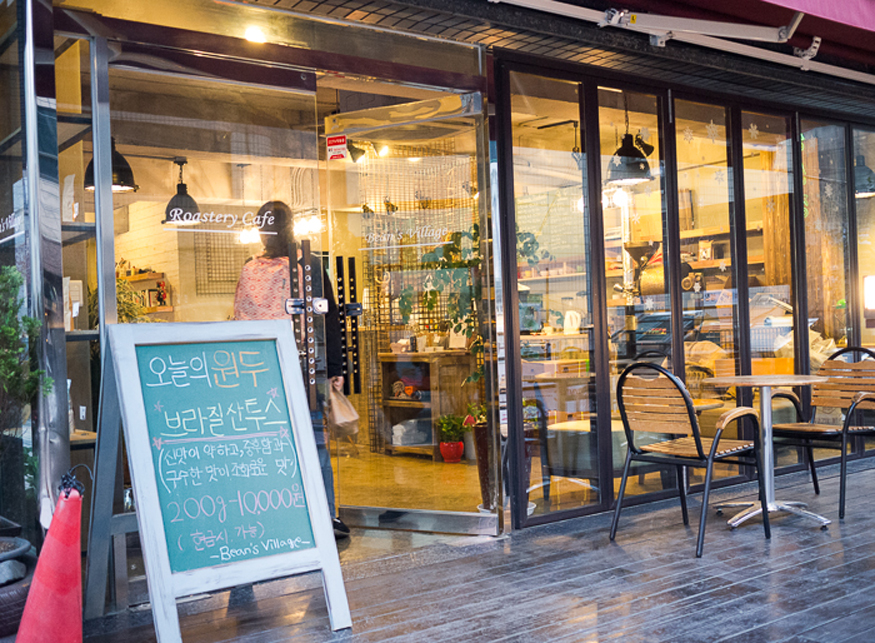The Peninsula
Overcaffeinated? Korea's Ubiquitous Coffee Shop Culture
Published July 6, 2017
Category: South Korea, Culture

By Nathaniel Curran
One thing that shocks most first time visitors to Korea is the ubiquity of coffee shops. You can’t find anywhere in Seoul that isn’t a short walk to the nearest café. The sheer magnitude of Korea’s passion for coffee is best expressed through numbers: Korea boasts the highest per capita number of cafes in the world. The result being there are an estimated 80,000 cafes in a country slightly smaller than Kentucky. While that number is staggering, the growth of the café industry is even more mind-boggling; back in 2011, Korea boasted only a measly 12,400 cafes. Even if one goes with a more conservative estimate in 2015 that put the number of cafes at around 50,000, the industry has undeniably grown by a factor of least five in the last decade.
While not as uniquely Korean as the noraebang (karaoke rooms) that seem to stud most streets in Korea, coffee culture permeates every neighborhood in Seoul, with tiny boutique cafes competing alongside behemoth Korean chains like Ediya Coffee, which as of last year boasted 1,800 stores.
Far from home, close to coffee
If you ever find yourself off the beaten path, perhaps on a deserted highway, be assured coffee will not be difficult to procure; convenience stores and rest-stops across carry dozens of varieties of pre-bottled coffee. These include heated cans of coffee as well as many varieties of refrigerated specialty coffees, such as white chocolate mochas and caramel macchiatos.
In addition, instant coffee is easy to come by in Korea. Sugary, delicious, and distributed in single-serving tubes that can also double as impromptu stirring sticks, they require only the addition of hot water. Even though consumption of instant coffee has declined in recent years, it was still an almost $900 million industry as of 2015. However, most Korean cafes would be loath to be considered in the same breath as instant coffee. Specialty coffee shops in Korea often charge more than 10,000won ($8) for their drinks, which advertise beans sourced from far flung locales and that are carefully curated by hagwon certified baristas.
From Gojong to Gangnam
Coffee came to Korea in the late 19th century, and Korea’s last monarch, Gojong, was a coffee fan, and the backer of Korea’s first coffee shop. Despite that initial foray into java, the modern Korean coffee habit owes its origins to the instant coffee powder that was common in American military bases during and after the Korean War. Instant coffee dominated the market for years, until, with the advent of Starbucks in Korea in the late 1990s, the Korean public was introduced to the joys of espresso. Now, espresso dominates the café market, with the singular “Americano” becoming Korea’s drink of choice.
Sadly, Korea’s more traditional beverage, tea, has not fared well against the onslaught of cafe-ization; the tea market has been cut in half since the late 2000s, while coffee sales climbed an incredible 1,598 percent.
The future of coffee in Korea
Experts have repeatedly predicted that Korea’s coffee market has reached saturation and that the glory days of café culture is coming to an end, only to be proven wrong. In fact, the intense competition in the café market has only given rise to more variations on the traditional coffee shop, including sleep cafes and exotic animal cafes that feature civet cats and wallabies.
While it’s hard to imagine that Koreans will drink even more coffee in the future, or that any possible ideas for cafes have not yet been exhausted, I’m confident that Korea will surprise us yet. In the meantime, Koreans can rest on the laurels of their vibrant coffee industry. Although Korea often gets called out for its overreliance on exports, what greater proof is there of a developed domestic economy than a country with a $5.7 billion dollar coffee market?
Whatever the future of cafes and coffee in Korea, the last two decades have been a heyday for Italian espresso machine makers, who are undoubtedly toasting a new sort of “Miracle” (or perhaps, “Americano?”) on the Han.
Nathaniel Curran is a PhD student at USC’s Annenberg School of Communication and a 2017 COMPASS Summer Fellow. The views expressed here are the author’s alone.
Photo from Dorothy’s photostream on flickr Creative Commons.
